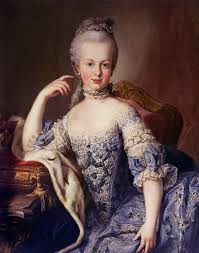| The first of 29 locks the Tor will pass through en route to Nuremberg |
| Bratislava and its castle |
was a city as modern as any,
| Modern Vienna. Who knew? |
dominated by several very recently built skyscrapers. Since my vision of Vienna ended with Hapsburgs, I was quite taken aback. It was only when we disembarked for our City Tour that “my” Vienna appeared. Even then, one quarter of the city was destroyed by Soviet bombs in 1945. So instead of the almost complete homogeneity of Budapest, Vienna’s blend of buildings is an often jarring set of contrasts. Old ornate facades from Austria’s glory days as the capital of an Empire, stand cheek by jowl with utilitarian buildings thrown up to replace bombed-out shells. Fortunately there is now some newer, and much finer, Modernist Architecture.
| Maria Theresa, Mistress of Her Domain |
Vienna was at one time the fourth largest city in Europe, capital of music (Mozart, Beethoven, Lizst), literature (Goethe), intellect (its university is 650 years old) and home to such modern figures as Sigmund Freud and most unfortunately, the little house painter, Adolf Hitler. But the old city of Vienna belongs to the Hapsburgs.
| The Guided Tours could not be better and they are all part of the fare. |
Viking River offered two Guided city tours. There was a full City Tour and one that focused on Vienna’s role as a capital of Art Deco. As mentioned in an earlier post, Viking’s daily shore excursions are included in their fares and they are wonderfully well done, with knowledgeable local guides who fill their talks with facts both informational and fun. We passed every major monument in the heart of the old city. Several of these are currently having their exteriors sandblasted after years of soot and grime have turned their limestone facades black. City Hall (the perfectly named Rathaus, translation not required) is one.
 |
| And you thought Don Draper’s judgment was off. |
And then there’s the very symbol of Vienna: Steffansdom, St. Stephen’s Cathedral. The Gothic South Tower rises 446 feet and is visible from almost everywhere in the city. It is considered the symbol of Vienna, what the Eiffel Tower is to Paris. Undergoing its sand blasting, one entire end of the Cathedral is covered in scaffolding. And on top of the scaffolding is a scrim. And printed on the scrim, courtesy of the Coca Cola Company of Atlanta, Georgia is a giant bottle of Coke and the headline: “I kissed Vienna”. Honestly, if this is not cringe-worthy, what is? I can only imagine the outcry if the similarly shrouded St. Patrick’s Cathedral in New York were decked out with a Coke bottle. Well according to our guide, this bit of crass commercialism replaced something even worse: An intimate apparel poster featuring an underwear-only model.
| Really, Starbucks? |
Second prize for “Most Chutzpah by an American Company” is surely the presence of 9 Starbucks branches. Since Coffee culture is an inherent part of Viennese culture, represented by the 600 Konditorei (Coffee Houses), some of which date back to Mozart, what is Starbucks thinking? Well the Viennese haven’t taken to Starbucks. Planned expansion to 60 branches has stopped and the only people who frequent Starbucks are those Americans who cannot leave home without their double Caramel Mocha Machiatto Latte. No self-respecting Austrian has darkened their doors after their initial curiosity was satisfied.
| Sacher Torte mitt Shlag |
At the end of the guided portion of the tours, there’s free time to pursue one’s own interests. Since Vienna’s Coffee culture will be the focus of one of the pieces I am doing for The Daily Meal, I took off to the Sacher Hotel Konditorei and its justly famous Sacher Torte. Stay tuned for that. Back to the ship for lunch, which I elected to take on the Aquavit Terrace in the bright sunshine.
 |
| Did Viennese Pastry get her into a whole lot of trouble? |
Extra charge excursions are offered only when time permits. In Vienna, I joined the tour of the Summer Palace of the Hapsburgs, Shöenbrunn Palace. This summer retreat, now well within the city limits, was home to Maria Theresa and her large brood of 16 children. Most famously, one of Maria Teresa’s daughters took the grandeur of the palace to heart. She was Marie Antoinette whose admonition to ‘let them eat cake’ sealed her fate at the guillotine. Whether the French Queen was referring to Sacher Torte is not recorded.
| Shoenbrunn’s Beautiful Fountain |
Shöenbrunn means “beautiful fountain” and an enormous one behind the palace is remniscent of the Trevi Fountain in Rome. That is, if the Trevi were surrounded by acres and acres of formal gardens. It was Sunday when we visited and, by all accounts, the first decent weather weekend in Spring. As a consequence, the place was mobbed and not just with the well-behaved passengers from the Viking Tor. People pushed through our group, elbowing their way to the front of the rope cords that keep the public a safe distance from the priceless furniture in each room. It was almost relief to get out of there.
| Goulash Soup, a perfect end to another perfect Viking Cruise Line day. |










